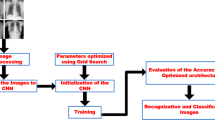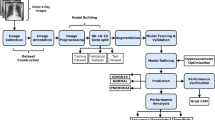Abstract
Around the world, lung disease is a prevalent cause of death and illness. In this article, we propose a lung disease detection system for the automated identification of critical lung diseases: 1. Tuberculosis 2. Regular Pneumonia 3. COVID Pneumonia and healthy individuals from chest X-ray (CXR) images. The proposed system incorporates a two-stage classification method using an ensemble of convolutional neural networks (CNNs). We evaluated the performance of the proposed system using various evaluation metrics with a test set containing 200 normal, 100 Tuberculosis, 200 Regular Pneumonia, and 100 COVID Pneumonia (a total of 600) CXR images. The proposed system achieves an average macro precision, recall, and F1-score of 0.99 and an accuracy of 0.99. The performance of the proposed system based on F1-Score (0.99) for three classes, namely Tuberculosis, Pneumonia, and COVID, is better than the following existing classification frameworks: ensemble of K-ResNets for the same three classes (F1-Score: 0.84), modified ResNet50 (F1-Score:0.89), KNN classifier with fractional multi-channel exponent moments (F1-Score: 0.89), VGG-16 (F1-Score: 0.89), and convolutional sparse support estimator network (F1-Score for COVID: 0.78). The proposed system can also determine the confidence associated with the challenging classification of Regular Vs. COVID Pneumonia. We also utilized visualization techniques like Grad-CAM and Saliency maps to analyze the features learned by the CNNs, to create transparency in the prediction.










Similar content being viewed by others
Data Availability
The data and supportive information are available from the authors upon request.
Abbreviations
- CXR :
-
Chest X-ray
- CNNs :
-
Convolutional neural networks
- GGOs :
-
Ground glass opacities
- AP :
-
Antero–posterior
- PA :
-
Posterior–anterior
References
Andreu J, Caceres J, Pallisa E, Martinez-Rodriguez M (2004) Radiological manifestations of pulmonary tuberculosis. Eur J Radiol 51(2):139–149
Anupama MA, Sowmya V, Soman KP (2019). Breast cancer classification using capsule network with preprocessed histology images. In: 2019 International conference on communication and signal processing (ICCSP) (p. 0143-0147). IEEE
Bekhet S, Hassaballah M, Kenk MA, Hameed MA (2020). An artificial intelligence based technique for COVID-19 diagnosis from chest X-Ray. In: 2020 2nd Novel Intelligent and Leading Emerging Sciences Conference (NILES) (p. 191-195). IEEE
Bermejo-Peláez D, Ash SY, Washko GR et al (2020) Classification of Interstitial Lung Abnormality Patterns with an Ensemble of Deep Convolutional Neural Networks. Sci Rep 10:338. https://doi.org/10.1038/s41598-019-56989-5
Bhosale YH, Patnaik KS (2022). IoT deployable lightweight deep learning application for COVID-19 detection with lung diseases using RaspberryPi. In: 2022 International Conference on IoT and Blockchain Technology (ICIBT) (pp. 1-6). IEEE
Bhosale YH, Patnaik KS (2022). Application of Deep Learning Techniques in Diagnosis of Covid-19 (Coronavirus): a Systematic Review. Neural Process Lett p. 1-53
Bhosale YH, Patnaik KS (2022). PulDi-COVID: Chronic Obstructive Pulmonary (Lung) Diseases With COVID-19 Classification Using Ensemble Deep Convolutional Neural Network From Chest X-Ray Images To Minimize Severity And Mortality Rates. Biomedical Signal Processing and Control, p. 104445
Bhosale YH, Zanwar S, Ahmed Z, Nakrani M, Bhuyar D, Shinde U (2022) Deep Convolutional Neural Network Based Covid-19 Classification From Radiology X-Ray Images For IoT Enabled Devices. In: 2022 8th International Conference on Advanced Computing and Communication Systems (ICACCS) (Vol. 1, p. 1398-1402). IEEE
Brunese L, Mercaldo F, Reginelli A, Santone A (2020) Explainable deep learning for pulmonary disease and coronavirus COVID-19 detection from X-rays. Comput Methods Programs Biomed 196:105608
Chen KC, Yu HR, Chen WS et al (2020) Diagnosis of common pulmonary diseases in children by X-ray images and deep learning. Sci Rep 10:17374. https://doi.org/10.1038/s41598-020-73831-5
Chollet F (2017). Xception: Deep learning with depthwise separable convolutions. In: Proceedings of the IEEE conference on computer vision and pattern recognition (p. 1251-1258)
Cleverley J, Piper J, Jones MM (2020) The role of chest radiography in confirming covid-19 pneumonia. BMJ 370:m242
Cohen JP, Morrison P, Dao L, Roth K, Duong TQ, Ghassemi M (2020). Covid-19 image data collection: Prospective predictions are the future. arXiv preprint arXiv:2006.11988
Das D, Howlett DC (2009) Chest X-ray manifestations of pneumonia. Surgery-Oxford Int Ed 27(10):453–455
Elaziz MA, Hosny KM, Salah A, Darwish MM, Lu S, Sahlol AT (2020) New machine learning method for image-based diagnosis of COVID-19. PLoS One 15(6):e0235187
Etlay JP, Kapoor WN, Fine MJ (1997) Does this patient have community-acquired pneumonia?: Diagnosing pneumonia by history and physical examination. JAMA 278(17):1440–1445
Fridadar M, Amer R, Gozes O, Nassar J, Greenspan H (2021). COVID-19 in CXR: from Detection and Severity Scoring to Patient Disease Monitoring. IEEE J Biomed Health Informat
Han Z, Wei B, Hong Y, Li T, Cong J, Zhu X, Wei H, Zhang W (2020) Accurate screening of COVID-19 using attention-based deep 3D multiple instance learning. IEEE Trans Med Imag 39(8):2584–2594
Hassaballah M, Awad AI (eds) (2020) Deep learning in computer vision: principles and applications. CRC Press, USA
He K, Zhang X, Ren S, Sun J (2016). Deep residual learning for image recognition. In: Proceedings of the IEEE conference on computer vision and pattern recognition (pp. 770-778)
Huang G, Liu Z, Van Der Maaten L, Weinberger KQ (2017) Densely connected convolutional networks. In: Proceedings of the IEEE conference on computer vision and pattern recognition (p. 4700-4708)
Infante M, Lutman RF, Imparato S, Di Rocco M, Ceresoli GL, Torri V, Morenghi E, Minuti F, Cavuto S, Bottoni E, Inzirillo F (2009) Differential diagnosis and management of focal ground-glass opacities. Eur Respirat J 33(4):821–827
Koch G, Zemel R, Salakhutdinov R (2015). Siamese neural networks for one-shot image recognition. In: ICML deep learning workshop (Vol. 2)
Kusuma S, Udayan D (2018) Machine learning and deep learning methods in heart disease (HD) research. Int J Pure Appl Math 119:1483–1496
Li MD, Chang K, Bearce B, Chang CY, Huang AJ, Campbell JP, Brown JM, Singh P, Hoebel KV, Erdoğmuş D, Ioannidis S (2020) Siamese neural networks for continuous disease severity evaluation and change detection in medical imaging. NPJ Digit Med 3(1):1–9
Liu Y, Wu YH, Ban Y, Wang H, Cheng MM (2020). Rethinking computer-aided tuberculosis diagnosis. In: Proceedings of the IEEE/CVF Conference on Computer Vision and Pattern Recognition (p. 2646-2655)
Oh Y, Park S, Ye JC (2020) Deep learning covid-19 features on cxr using limited training data sets. IEEE Trans Med Imag 39(8):2688–2700
Sabour S, Frosst N, Hinton GE (2017). Dynamic routing between capsules. arXiv preprint arXiv:1710.09829
Selvaraju RR, Cogswell M, Das A, Vedantam R, Parikh D, Batra D (2017) Grad-cam: Visual explanations from deep networks via gradient-based localization. In: Proceedings of the IEEE international conference on computer vision (p. 618-626)
Simonyan K, Vedaldi A, Zisserman A (2013). Deep inside convolutional networks: visualising image classification models and saliency maps. arXiv preprint arXiv:1312.6034
Simonyan K, Zisserman A (2014). Very deep convolutional networks for large-scale image recognition. arXiv preprint arXiv:1409.1556
Swapna G, Vinayakumar R, Soman KP (2018) Diabetes detection using deep learning algorithms. ICT express 4(4):243–246
Szegedy C, Liu W, Jia Y, Sermanet P, Reed S, Anguelov D, Erhan D, Vanhoucke V, Rabinovich A (2015). Going deeper with convolutions. In: Proceedings of the IEEE conference on computer vision and pattern recognition (p. 1-9)
Tan M, Le Q (2019) Efficientnet: Rethinking model scaling for convolutional neural networks. In: International Conference on Machine Learning (p. 6105-6114). PMLR
Thomas E, Delabat S, Carattini YL, Andrews DM (2021) SARS-CoV-2 and variant diagnostic testing approaches in the United States. Viruses 13(12):2492
Xu S, Wu H, Bie R (2018) CXNet-m1: Anomaly detection on chest X-rays with image-based deep learning. IEEE Access 7:4466–4477
Yadav P, Menon N, Ravi V, Vishvanathan S (2021). Lung-gans: Unsupervised representation learning for lung disease classification using chest ct and x-ray images. IEEE Trans Eng Manag
Yamaç M, Ahishali M, Degerli A, Kiranyaz S, Chowdhury ME, Gabbouj M (2021). Convolutional Sparse Support Estimator-Based COVID-19 Recognition From X-Ray Images. IEEE Trans Neural Netw Learn Syst
Funding
The authors have not disclosed any funding.
Author information
Authors and Affiliations
Corresponding author
Ethics declarations
Conflict of interest
None.
Research involving human participants and/or animals
None.
Informed consent
None.
Additional information
Publisher's Note
Springer Nature remains neutral with regard to jurisdictional claims in published maps and institutional affiliations.
Rights and permissions
Springer Nature or its licensor (e.g. a society or other partner) holds exclusive rights to this article under a publishing agreement with the author(s) or other rightsholder(s); author self-archiving of the accepted manuscript version of this article is solely governed by the terms of such publishing agreement and applicable law.
About this article
Cite this article
Ganeshkumar, M., Ravi, V., Sowmya, V. et al. Two-stage deep learning model for automate detection and classification of lung diseases. Soft Comput 27, 15563–15579 (2023). https://doi.org/10.1007/s00500-023-09167-9
Accepted:
Published:
Issue Date:
DOI: https://doi.org/10.1007/s00500-023-09167-9




